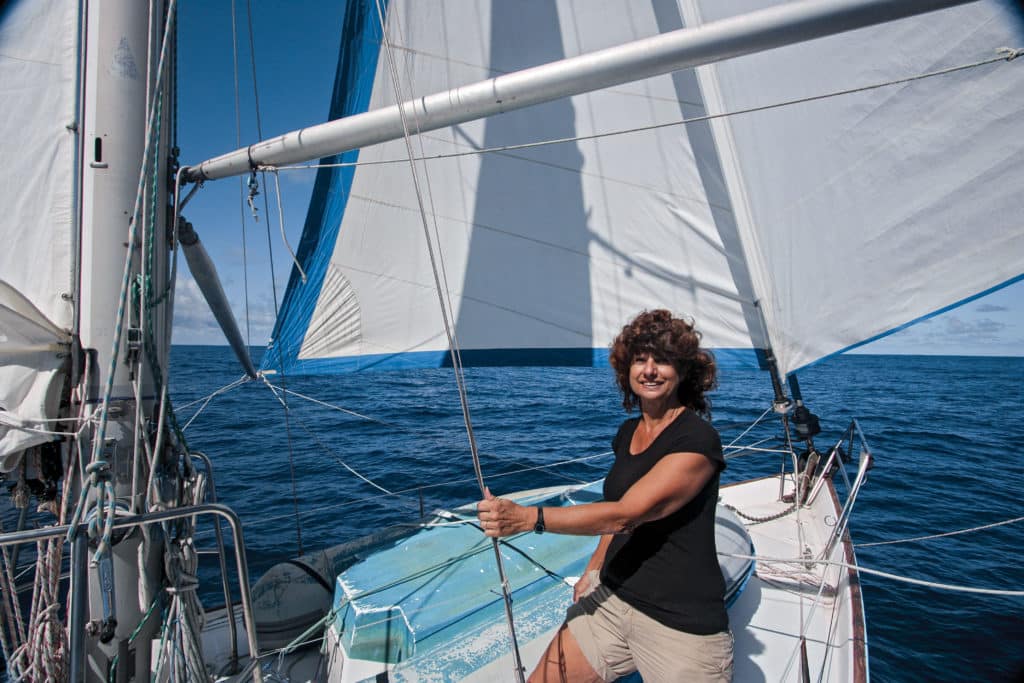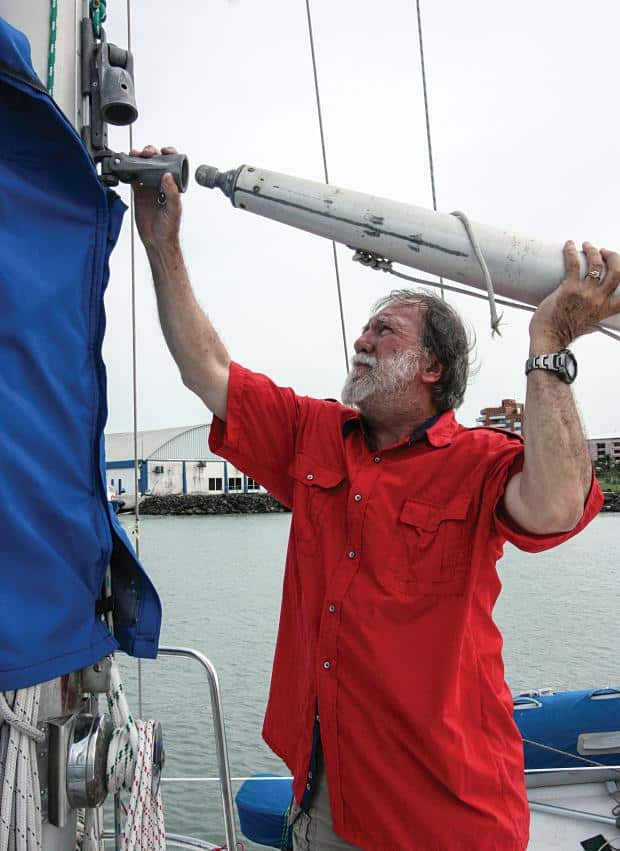
“Let’s go on deck,” I said, apropos of nothing. We did.
“Ouch,” I screamed. “Goddam it!”
“What’s the matter?” asked the owner.
“I stubbed my toe,” I said angrily, “on this darn spinnaker pole!”
“It’s always in the way,” admitted the owner.
“Mine too,” I admitted. “I don’t know why I don’t throw it overboard.”
“Well,” said the owner, “we used it a couple of years ago.”
“Exactly!” I agreed. “These things don’t pull their own weight! They clutter but they don’t flutter, so to speak. I have a policy: If I ain’t used it in the last year, I deep-six it. There’s no room for useless toe-stubbers offshore. Hell, a deck obstruction like this could cost a man his life!”
“Well,” the owner replied.
“Yeah, I know what you mean,” I concurred. “Inertia isn’t limited to objects. Our minds possess it too. You’ve had that silly pole for a while and it has always been there, so it stays there, even though you know it shouldn’t. If you had any courage and guts and were a decisive, logical person of definitive action, why, you’d deep-six that useless sucker tomorrow!”
“Well, I might bring it to a marine flea market someday,” he said.
“Actually,” I said, zeroing in for the kill, “I am bringing some rusty treasures-of-the-bilge to this Sunday’s flea market at Lagoonies or to next week’s Time Out boatyard flea market — want me to lug this piece of crap along?”
Thus I came by my long-sought-after second spinnaker pole, an exact match for the one on Ganesh. That was the easy part, though. I have a silver tongue, that’s a given. But the next step would be truly a step beyond, and to pull it off, we’d have to have our patter down perfect.
We arrived alongside the guy’s Wauquiez (with a dinghy full of tools) and yelled, “Good news!” As he poked his head out of the companionway, I fanned the $350 with a grin. “We’re here to give you money!”
This is a line that never fails.
My wife, Carolyn, was with me. I nodded. She started off-loading our toolboxes onto his foredeck.
“Great!” he said, reaching for the money. Alas, I was just a tad too far away. “Let me come around to the other side,” I said. “Better yet, wait, I’ll come aboard!”
Meanwhile, Carolyn was setting up the bosun’s chair and running an extension cord back to our generator in the dinghy.
“Hey, wait one sec,” the guy said with a frown, obviously perplexed at our tools and hasty preparations.
“Not to worry!” I said with a grin. “We’re here for the bell, the part that the butt end of the pole fits into, the part that slides up and down the mast.”
“But,” he protested.
“No, not ‘but,”’ I corrected. “‘Butt!’ That’s the inboard end. Butts and poles are sold together usually. Anyway, it is useless to you at this point, and it won’t take but a jiffy for us to remove it for you.”
Carolyn fired up the genset in the dinghy, hoisted me aloft, and I proceed to drill out all the rivets in his forward-facing spin track.
Little bits of metal started raining down on his teak deck, and the guy was forced to cup a hand over his squinting eyes to protect them. I worked fiendishly fast.
“Wouldn’t it be better just to remove the end cap from the track?” he asked, while looking down, grimacing and blinking furiously.
“Lucky for you, I am an expert on all things nautical. The end cap has a backing plate, and all the parts are likely frozen together inside the mast, thanks to three decades of salt corrosion. This here looks like a major job, but it’s nothing, really. There! Ha, I’ve got it off already! Carolyn, please hoist the stainless-steel Type 316 rivets, and we’re done.”
The last thing I said to the guy was “And your boat will be even faster now, minus that clunky pole and the heavy bell aloft!”
Sure, it was a tricky and risky gambit, and probably hugely unfair, but I’d finally realized a life goal: I now had a well-found cruising boat with two perfectly functioning, lightweight, matching, spinnaker poles. That’s something I’d coveted since my childhood.
Childhood? Yes!
We Goodlanders lust after a different kettle of fish, so to speak. I didn’t read Dick and Jane as a liveaboard 7-year-old. By the swaying light of a gimbaled kerosene cabin lamp, I read of Harry Pidgeon of the Seabird yawl Islander and Joshua Slocum of Spray. I read about seamen and voyagers.
These men were, and still are, my heroes. Neither had a modern autopilot nor a self-steering windvane, and yet they sailed the world on engineless craft. How? By managing to get their boats to self-steer. This is easy upwind, but far, far more difficult downwind.
The key is the pole!
The pole allows a number of wonderful things to happen: Your headsail stays fuller far longer, at a greater variance of course and apparent wind angle, and your sail doesn’t pop endlessly. This preserves both the sail and your sanity. Sailing with the jib poled out is faster too, because you’re showing more acreage to the wind.
Perfect, right? Well, no.
Running wing-and-wing with jib and main has a number of disadvantages, especially over vast distances. The chafe on your mainsail against your shrouds and spreaders is tremendous. The boat rolls horribly, and the center of effort of the mainsail is so far aft on your sail plan, it has a tendency to spin the boat around, to encourage her to round up in a puff.

The secret is two poles, which let you sail with two jibs and no mainsail. Now a savage gust wants to push you back on course, not round you up. With little sacrifice in forward thrust (speed), the jibs can be trimmed to minimize the famous trade-wind roll so often referred to by early circumnavigators. And even better, the jib sheets can simply be led to the tiller (if fitted) and the boat will be immediately yanked back on course by the fuller jib. The sailboat will steer itself dead-down for months at a time, in both light and heavy air. An ocean sailor’s dream come true, eh?
I have set up Ganesh to use this trade-wind twins concept to good effect. I now have two poles always ready to go: pre-mounted on the mast and with their two fore and aft guys and halyards pre-led and ready to go the entire time we are at sea in moderate weather and trade-wind conditions. And that’s 95 percent of the time.
If I want a jib poled out, I just amble forward to place the jib sheet in the pole end jaws and hoist, as Carolyn pulls its guy and sheet aft. Within seconds (or a minute, if there’s a snag) we have our jib, or jibs, poled out and ready to click off thousands of effortless nautical miles. (If we’re hit by a severe squall, we roll the roller furling jibs up but leave the guyed poles aloft.)
Of course, spinnaker poles can be used on spinnakers too. We have two of these, an asymmetrical kite for reaching and a symmetrical one for dead-down. But frankly, we only use our chutes in extremely light airs, when I’m suffering a bad hot flash of testosterone, or when a photographer’s boat is about. Why rush about pulling strings when the whole idea of cruising is to relax?
Another reason we love our Heavenly Twins, as I refer to the poles, is because we’re
cheap, frugal and penny-pinching cruisers, and proud of it. Thus we never go to marinas, but anchor out in the fresh air instead. Alas, our planet is suffering from marina-creep, as more and more calm-water anchorages are being converted into profit centers by shore-dwelling developers. I’m afraid there is no end of this let’s-kill-all-the-mangroves-and-wonder-why-there’s-no-fish trend. So we spend more and more time in rolly anchorages, which is where our (misnamed) “flopper stoppers” come into play.
These are just weighted plywood triangles, measuring 3 feet to a side. They hang in the water at the ends of our twin poles and dampen the roll just enough to prevent our hull from seeking its natural resonance with the beam-on waves.
At once, a horribly uncomfortable anchorage is, as if by magic, converted into a lovely, lonely spot to spend a month or two puttering about while taking a break from deep-water passagemaking.
We also use our roll inhibitors while anchored inside landless atolls and even when totally becalmed in the Intertropical Convergence Zone. In extremely calm spots like the Sargasso Sea, the entire ocean is our anchorage once the flopper stoppers are deployed.
Sometimes, surrounded by high-tech gizmos, we forget to look back in the pages of our maritime traditions for things that work flawlessly, year after cruising year. Poles and triangles of wood are pretty dependable and simple to operate, and their current drain is minimal. True, there’s no app for them and they can’t be launched via your iPad, but still, they are a worthy consideration for your offshore cruising gear.








